THE BIG BANG THEORY
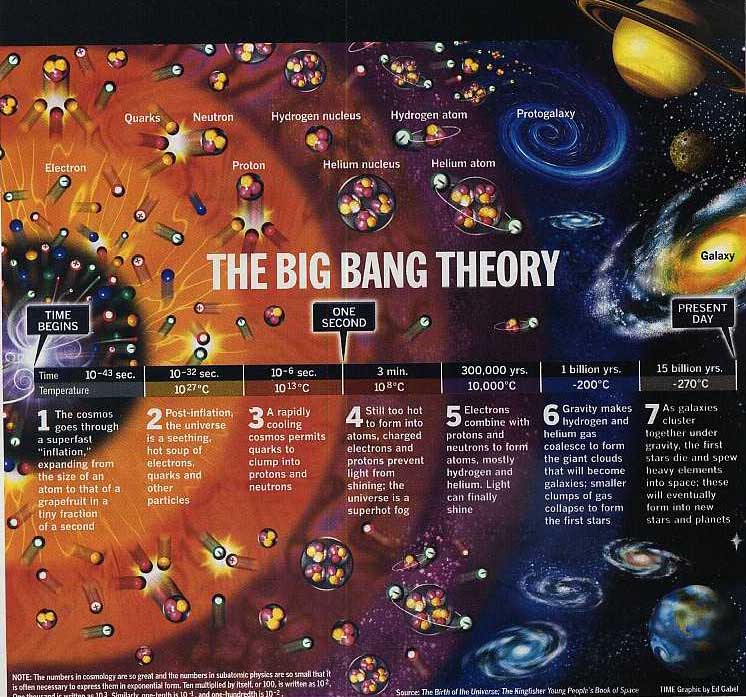
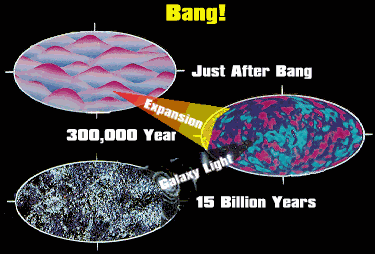
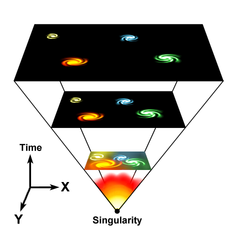
Georges Lemaitre proposed what became known as the Big Bang theory of the origin of the universe, he called it his "hypothesis of the primeval atom". The framework for the model relies on Albert Einstein's general relativity and on simplifying assumptions (such as homogeneity and isotropy of space). The governing equations had been formulated by Alexander Friedmann. In 1929, Edwin Hubble discovered that the distances to far away galaxies were generally proportional to their redshifts - an idea originally suggested by Lemaitre in 1927. Hubble's observation was taken to indicate that all very distant galaxies and clusters have an apparent velocity directly away from our vantage point: the farther away, the higher the apparent velocity.
If the distance between galaxy clusters is increasing today, everything must have been closer together in the past. This idea has been considered in detail back in time to extreme densities and temperatures, and large particle accelerators have been built to experiment on and test such conditions, resulting in significant confirmation of the theory, but these accelerators have limited capabilities to probe into such high energy regimes.
Without any evidence associated with the earliest instant of the expansion, the Big Bang theory cannot and does not provide any explanation for such an initial condition; rather, it describes and explains the general evolution of the universe since that instant. The observed abundances of the light elements throughout the cosmos closely match the calculated predictions for the formation of these elements from nuclear processes in the rapidly expanding and cooling first minutes of the universe, as logically and quantitatively detailed according to Big Bang nucleosynthesis.
Fred Hoyle is credited with coining the term Big Bang during a 1949 radio broadcast. It is popularly reported that Hoyle, who favored an alternative "steady state" cosmological model, intended this to be pejorative, but Hoyle explicitly denied this and said it was just a striking image meant to highlight the difference between the two models.
Hoyle later helped considerably in the effort to understand stellar nucleosynthesis, the nuclear pathway for building certain heavier elements from lighter ones. After the discovery of the cosmic microwave background radiation in 1964, and especially when its spectrum (i.e., the amount of radiation measured at each wavelength) was found to match that of thermal radiation from a black body, most scientists were fairly convinced by the evidence that some version of the Big Bang scenario must have occurred.
The Big Bang theory depends on two major assumptions: the universality of physical laws, and the cosmological principle. The cosmological principle states that on large scales the Universe is homogeneous and isotropic.
These ideas were initially taken as postulates, but today there are efforts to test each of them. For example, the first assumption has been tested by observations showing that largest possible deviation of the fine structure constant over much of the age of the universe is of order 10-5. Also, general relativity has passed stringent tests on the scale of the solar system and binary stars while extrapolation to cosmological scales has been validated by the empirical successes of various aspects of the Big Bang theory.
If the large-scale Universe appears isotropic as viewed from Earth, the cosmological principle can be derived from the simpler Copernican principle, which states that there is no preferred (or special) observer or vantage point. To this end, the cosmological principle has been confirmed to a level of 10-5 via observations of the CMB. The Universe has been measured to be homogeneous on the largest scales at the 10% level.
History
In 1610, Johannes Kepler used the dark night sky to argue for a finite universe (Olbers paradox). Seventy-seven years later, Isaac Newton described large-scale motion throughout the universe.
The description of a universe that expanded and contracted in a cyclic manner was first put forward in a poem published in 1791 by Erasmus Darwin. Edgar Allan Poe presented a similar cyclic system in his 1848 essay titled Eureka: A Prose Poem; it is obviously not a scientific work, but Poe, while starting from metaphysical principles, tried to explain the universe using contemporary physical and astronomical knowledge. Ignored by the scientific community and often misunderstood by literary critics, its scientific implications have been reevaluated in recent times.
According to Poe, the initial state of matter was a single "Primordial Particle". "Divine Volition", manifesting itself as a repulsive force, fragmented the Primordial Particle into atoms. Atoms spread evenly throughout space, until the repulsive force stops, and attraction appears as a reaction: then matter begins to clump together forming stars and star systems, while the material universe is drawn back together by gravity, finally collapsing and ending eventually returning to the Primordial Particle stage in order to begin the process of repulsion and attraction once again. This part of Eureka describes a Newtonian evolving universe which shares a number of properties with relativistic models, and for this reason Poe anticipates some themes of modern cosmology.
Also in that decade, Albert Einstein's theory of general relativity was found to admit no static cosmological solutions, given the basic assumptions of cosmology described in the Big Bang's theoretical underpinnings. The universe (i.e., the space-time metric) was described by a metric tensor that was either expanding or shrinking (i.e., was not constant or invariant), this result coming from an evaluation of the field equations of the general theory, led Einstein (at first) himself to consider that his formulation of the field equations of the general theory to be in error and he tried to correct it by adding a cosmological constant.
This constant would restore to the general theory's description of space-time an invariant metric tensor for the fabric of space/existence. The first person to seriously apply general relativity to cosmology without the stabilizing cosmological constant was Alexander Friedmann. Friedmann derived the expanding-universe solution to general relativity field equations in 1922. Friedmann's 1924 papers included "Uber die Moglichkeit einer Welt mit konstanter negativer Krummung des Raumes" (About the possibility of a world with constant negative curvature) which was published by the Berlin Academy of Sciences on 7 January 1924. Friedmann's equations describe the Friedmann-Lemaitre-Robertson-Walker universe.
In 1927, the Belgian Catholic priest Georges Lema”tre proposed an expanding model for the universe to explain the observed redshifts of spiral nebulae and forecast the Hubble law. He based his theory on the work of Einstein and De Sitter, and independently derived Friedmann's equations for an expanding universe. Also the red shifts themselves were not constant but varied in such manner as to lead to the conclusion that there was a definite relationship between amount of red-shift of nebulae; and their distance from observers.
In 1929, Edwin Hubble provided a comprehensive observational foundation for Lemaitre's theory. Hubble's experimental observations discovered that; relative to the Earth and all other observed bodies; galaxies are receding in every direction at velocities (calculated from their observed red-shifts) directly proportional to their distance from the Earth and each other.
In 1929 Hubble and Milton Humason formulated the empirical Redshift Distance Law of galaxies, nowadays known as Hubble's law, which, once the redshift is interpreted as a measure of recession speed, is consistent with the solutions of EinsteinÕs General Relativity Equations for a homogeneous, isotropic expanding space. The isotropic nature of the expansion was direct proof that it was the space (the fabric of existence) itself that was expanding, not the bodies in space that were simply moving further outward and apart into an infinitely larger preexisting empty void. It was this interpretation that led to the concept of the expanding universe. The law states that the greater the distance between any two galaxies, the greater their relative speed of separation. This discovery later resulted in the formulation of the Big Bang model.
In 1931, Lemaitre proposed in his "hypotheses de l'atome primitif" (hypothesis of the primeval atom) that the universe began with the "explosion" of the "primeval atom" - what was later called the Big Bang. Lemaitre first took cosmic rays to be the remnants of the event, although it is now known that they originate within the local galaxy. Lemaitre had to wait until shortly before his death to learn of the discovery of cosmic microwave background radiation, the now believed remnant radiation of a dense and hot phase in the early Universe.

Comparison of the predictions of the standard Big Bang model with experimental measurements. The power spectrum of the cosmic microwave background radiation anisotropy is plotted in terms of the angular scale (or multipole moment) (top).
For a number of years the support for these theories was evenly divided, with the slight imbalance in the fact that the Big Bang theory could explain both the formation and the observed abundances of hydrogen and helium, whereas the Steady State could explain how they were formed but not why they should have the observed abundances.
However, the observational evidence began to support the idea that the universe evolved from a hot dense state. Young objects such as quasars were only observed at the very edges of the universe, indicating that such objects only existed in times long past, whereas the Steady State predicted that young galaxies should be scattered all over the universe, both near and far. In addition, the discovery of the cosmic microwave background radiation in 1965 was considered the death knell of the Steady State, although, as Big Bang skeptics point out, this prediction was only qualitative, and failed to predict the actual temperature of the CMB. After some reformulation, the Big Bang has been regarded as the best theory of the origin and evolution of the cosmos.
Before the late 1960s, many cosmologists thought the infinitely dense and physically paradoxical singularity at the starting time of Friedmann's cosmological model could be avoided by allowing for a universe which was contracting before entering the hot dense state and starting to expand again. This was formalized as Richard Tolman's oscillating universe. In the sixties, Stephen Hawking and others demonstrated that this idea was unworkable, and the singularity is an essential feature of the physics described by Einstein's gravity. This led the majority of cosmologists to accept the notion that the universe as currently described by the physics of general relativity has a finite age. However, due to a lack of a theory of quantum gravity, there is no way to say whether the singularity is an actual origin point for the universe or whether the physical processes that govern the regime cause the universe to be effectively eternal in character.
Huge advances in Big Bang cosmology were made in the late 1990s and the early 21st century as a result of major advances in telescope technology in combination with large amounts of satellite data, such as that from COBE and the Hubble Space Telescope. In 2003, NASA's WMAP took more detailed pictures of the universe by means of the cosmic microwave background radiation. The images can be interpreted to indicate that the universe is 13.7 billion years old (within one percent error) and that the Lambda-CDM model and the inflationary theory are correct. No other cosmological theory can yet explain such a wide range of observed parameters, from the ratio of the elemental abundances in the early Universe to the structure of the cosmic microwave background, the observed higher abundance of active galactic nuclei in the early Universe and the observed masses of clusters of galaxies.
History of the Big Bang Theory
Big Bang Wikipedia
Religious interpretations of the Big Bang theory Buddhist, Christian and Jewish, Hindu, Islam, Taoist
Theoretical Underpinnings
Timeline of the Big Bang
In the News ...
String Theorists Simulate the Big Bang Live Science - December 13, 2011
Japanese physicists have created a string theory model that simulates the birth of the universe. In their model, the Big Bang was a "symmetry-breaking event" - a fluctuation that caused three spatial dimensions to break free from the other six dimensions of string theory, then rapidly unfurl to produce our universe's observed 3D structure. String theory - a proposed "theory of everything" that unites quantum mechanics and general relativity together in one complete picture - models elementary particles as oscillating lines ("strings") rather than dimensionless points. In order for the math to work, string theory requires that there be 10 dimensions: nine of space and one of time. Our universe only appears to have three spatial dimensions, string theorists say, because the other six are curled up in undetectably tiny bundles called Calabi-Yau manifolds, which are a minuscule 10^-33 centimeters across.
String theory researchers simulate big-bang on supercomputer PhysOrg - December 14, 2011
A trio of Japanese physicists have applied a reformulation of string theory, called IIB, whereby matrices are used to describe the properties of the physical universe, on a supercomputer, to effectively show that the universe spontaneously ballooned in three directions, leaving the other six dimensions tightly wrapped, as string theory has predicted all along.
Could the Big Bang have been a quick conversion of antimatter into matter? PhysOrg - July
19, 2011
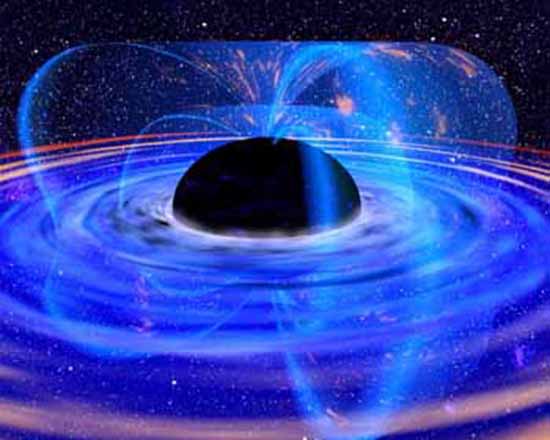
Suppose at some point the universe ceases to expand, and instead begins collapsing in on itself (as in the ÒBig CrunchÓ scenario), and eventually becomes a supermassive black hole. The black holeÕs extreme mass produces an extremely strong gravitational field. Through a gravitational version of the so-called Schwinger mechanism, this gravitational field converts virtual particle-antiparticle pairs from the surrounding quantum vacuum into real particle-antiparticle pairs. If the black hole is made from matter (antimatter), it could violently repel billions and billions of antiparticles (particles) out into space in a fraction of a second, creating an ejection event that would look quite similar to a Big Bang.
Matter Melts in Superhot Particle Collisions Live Science - June 23, 2011

By creating a soup of subatomic particles similar to what the Big Bang produced, scientists have discovered the temperature boundary where ordinary matter dissolves. Normal atoms will be converted into another state of matter - a plasma of quarks and gluons - at a temperature about 125,000 times hotter than the center of the sun, physicists said after smashing the nuclei of gold atoms together and measuring the results. While this extreme state of matter is far from anything that occurs naturally on Earth, scientists think the whole universe consisted of a similar soup for a few microseconds after the Big Bang about 13.7 billion years ago.
Cosmos may show echoes of events before Big Bang BBC - November 27, 2010

Evidence of events that happened before the Big Bang can be seen in the glow of microwave radiation that fills the Universe, scientists have asserted. Renowned cosmologist Roger Penrose said that analysis of this cosmic microwave background showed echoes of previous Big Bang-like events. The events appear as "rings" around galaxy clusters in which the variation in the background is unusually low.
Planck telescope beams back first images of the fall out after the Big Bang Telegraph.co.uk - September 17, 2009
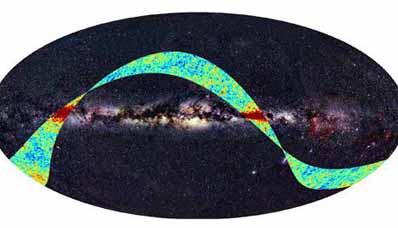
The Planck observatory that was sent into space to record the origins of the universe has beamed back the first glimpse into the past.
Cosmic 'treasure trove' revealed BBC - March 11, 2008

A Nasa space probe measuring the oldest light in the Universe has found that cosmic neutrinos made up 10% of matter shortly after the Big Bang. Five years of study data also shows that the first stars took over half a billion years to light up the Universe. WMAP launched in 2001 on a mission to measure remnants of light left over from the Big Bang. Scientists say it is collecting a "treasure trove" of information about the Universe's age, make-up and fate. The Wilkinson Microwave Anisotropy probe (WMAP) is mapping the Cosmic Microwave Background (CMB) radiation in the sky. This is the oldest light in the Universe, shifted to microwave wavelengths as the Universe expanded over 13.7 billion years.
What happened before the Big Bang? Physorg - August 3, 2006
Though Einstein's theory of general relativity does an excellent job of describing the universe almost back to its beginning, near the Big Bang matter becomes so dense that relativity breaks down. Beyond that point, we need to apply quantum tools that were not available to Einstein. Now Ashtekar and two of his post-doctoral researchers, Tomasz Pawlowski and Parmpreet Singh, have done just that. Using a theory called loop quantum gravity, they have developed a mathematical model that skates right up to the Big Bang -- and steps through it. On the other side, Ashtekar says, exists another universe with space-time geometry similar to our own, except that instead of expanding, it is shrinking. "In place of a classical Big Bang, there is in fact a quantum Bounce," he says.
No comments:
Post a Comment